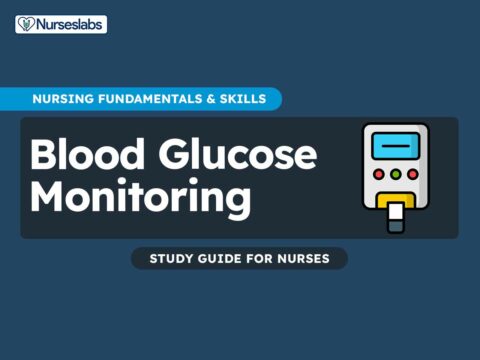Blood transfusion (BT) therapy involves transfusing whole blood or blood components (specific portion or fraction of blood lacking in patient). Learn the concepts behind blood transfusion therapy and the nursing management and interventions before, during and after the therapy.
What is Blood Transfusion?
A blood transfusion is a procedure in which donated blood or blood components are transferred into a patient’s bloodstream. This procedure is used to replace lost blood during surgery, injury, or illness, and to treat various medical conditions that affect the blood, such as anemia, clotting disorders, and certain cancers. Blood transfusions can involve whole blood or specific components of blood, such as red blood cells, platelets, plasma, or cryoprecipitate, depending on the patient’s needs.
Before a transfusion, the donor’s blood type must be compatible with the recipient’s to prevent clumping and hemolysis, which can be fatal. Blood types (A, B, AB, O) are determined by specific antigens on red blood cells. The Rh factor is another antigen; people are either Rh-positive or Rh-negative. Rh-negative individuals must receive Rh-negative blood to avoid complications.
Blood donors are carefully screened and tested for diseases such as HIV, hepatitis B and C, syphilis, and West Nile virus. Donors are also evaluated based on their health history and lifestyle. Patients can pre-donate their own blood for future use (autologous transfusion), reducing the risk of infection and complications from mismatched blood.
Indications of Blood Components
Blood transfusions and blood products are essential medical treatments that address a variety of conditions by restoring blood volume, enhancing oxygen-carrying capacity, and correcting clotting deficiencies. This detailed overview covers the specific components of blood and their respective indications:
- Whole blood transfusion is indicated for patients requiring both increased oxygen-carrying capacity and blood volume restoration, especially in urgent situations where there is no time to prepare or obtain specific blood components.
- Packed red blood cells contain 100% of the erythrocytes, 100% of the leukocytes, and 20% of the plasma originally present in one unit of whole blood. They are used primarily for patients with anemia, cardiovascular failure, or gastrointestinal bleeding who need an increase in red blood cell count without the additional fluid volume that comes with whole blood. These should be transfused over 2 to 3 hours, and if the patient cannot tolerate this volume within 4 hours, the blood bank may divide the unit into smaller volumes. One unit raises hemoglobin by approximately 1% and hematocrit by 3%.
- Leukocyte-poor packed RBCs are indicated for patients who have previously experienced febrile non-hemolytic reactions. This component reduces the number of leukocytes, thereby minimizing the risk of febrile reactions.
- Platelets are crucial for treating or preventing bleeding in patients with low platelet counts or dysfunctional platelets. They can be either HLA (human leukocyte antigen) matched or unmatched. Platelets should be administered as rapidly as tolerated, usually 4 units every 30 to 60 minutes, and each unit should increase the platelet count by 6,000 to 10,000/mm³. Poor increases may occur due to alloimmunization, bleeding, fever, infection, autoimmune destruction, and hypertension.
- Granulocytes, containing basophils, eosinophils, and neutrophils, are beneficial for patients with severe neutropenia who are not responding to antibiotic treatment. These white blood cells play a critical role in fighting infections and are indicated for infected, severely granulocytopenic patients (less than 500/mm³) expected to have prolonged granulocyte suppression.
- Plasma is used for patients requiring volume expansion and those with low plasma proteins or clotting factors. There are different types of plasma products:
- Fresh frozen plasma (FFP) contains all coagulation factors, including factors V and VIII, and is essential for patients with coagulation deficiencies, liver disease, or those needing rapid reversal of anticoagulation therapy. It should be administered as rapidly as tolerated because coagulation factors degrade after thawing.
- Single donor plasma contains all stable coagulation factors but has reduced levels of factors V and VIII. It is particularly preferred for reversing the effects of Coumadin (warfarin)-induced anticoagulation.
- Albumin is a significant plasma protein that contributes to plasma oncotic pressure. It is used to expand blood volume in patients suffering from hypovolemic shock or hypoalbuminemia, providing essential support in maintaining blood pressure and volume.
- Cryoprecipitate is a plasma derivative rich in factor VIII, fibrinogen, factor XIII, and fibronectin. It is indicated for treating hemophilia A, Von Willebrand’s disease, disseminated intravascular coagulation (DIC), and uremic bleeding, addressing various critical bleeding disorders.
- Factor IX concentrate is a highly concentrated form of factor IX, prepared by pooling, fractionating, and freeze-drying large volumes of plasma. It is specifically indicated for treating hemophilia B, providing the necessary clotting factor to manage this condition. This product carries a high risk of hepatitis due to pooling from multiple donors.
- Factor VIII concentrate is prepared by pooling, fractionating, and freeze-drying large volumes of plasma. It is indicated for treating hemophilia A and is heat-treated to reduce the risk of transmitting hepatitis and HIV.
- Prothrombin complex contains prothrombin and factors VII, IX, X, and some factor XI. It is used for addressing congenital or acquired deficiencies of these factors, including the reversal of warfarin therapy. This complex plays a vital role in correcting clotting deficiencies and managing bleeding disorders.
Administering a Blood Transfusion
Proper administration of a blood transfusion is critical to ensure patient safety and effectiveness. The following guidelines and steps outline the essential equipment and procedures needed.
Equipment
The following equipment are necessary:
- Blood product
- Blood administration set (tubing with in-line filter and Y for saline administration)
- 0.9% normal saline for IV infusion
- IV pole
- Clean gloves and additional PPE as indicated
- Tape (hypoallergenic)
- Second RN for verification of blood product and patient information
Procedure
To ensure a safe and effective blood transfusion, follow these detailed steps:
Pre-transfusion preparation and verification
1. Verify medical order and consent.
Ensure the medical order for the blood transfusion is accurate, confirm that the informed consent documentation is completed, and note any pretransfusion medication orders. Administer any pretransfusion medications at least 30 minutes before starting the transfusion.
2. Gather equipment.
Collect all necessary equipment and bring it to the bedside to ensure everything is readily available.
3. Perform hand hygiene and put on PPE.
Maintain a sterile environment by performing hand hygiene and donning personal protective equipment as needed.
4. Identify the patient.
Confirm the patient’s identity using at least two identifiers to ensure the correct individual receives the blood transfusion.
5. Prepare the patient.
Explain the procedure to the patient, ensure their privacy, and inquire about any previous transfusion reactions. Advise the patient to report any unusual symptoms immediately.
Set-up and initiation
6. Prime the administration set.
Prepare the blood administration set by priming it with normal saline.
7. Initiate venous access.
If not already in place, initiate peripheral venous access and connect the administration set.
8. Obtain the blood product.
Retrieve the blood product from the blood bank according to facility policy, ensuring proper handling and transportation. Never warm blood in a microwave. Use a blood-warming device if necessary.
9. Verify with two nurses.
Have two nurses verify the medical order, informed consent, patient identification number, name, blood group, type, expiration date, and inspect the blood product for clots or abnormalities.
10. Take baseline vital signs.
Record baseline vital signs before starting the transfusion to have a reference point for comparison.
11. Prepare for infusion.
Put on gloves, set up the infusion device, and prime the blood side of the administration set. Remove gloves after setup. Ensure the infusion device is appropriate for blood transfusions.
Transfusion administration
12. Start the transfusion slowly.
Begin the transfusion at a slow rate (25–50 mL for the first 15 minutes) and stay with the patient to monitor for any immediate reactions.
13. Monitor the patient.
Continuously observe for signs of flushing, dyspnea, itching, hives, or any unusual comments from the patient.
14. Increase the infusion rate.
If no adverse reactions occur within the initial period, increase the infusion rate to complete the transfusion within the prescribed time frame, ensuring it does not exceed 4 hours.
15. Reassess vital signs.
Check and record vital signs 15 minutes after starting the transfusion and periodically thereafter according to facility policy.
16. Maintain the flow rate.
Adjust the flow rate as necessary, considering the patient’s overall condition and response to the transfusion.
17. Monitor for reactions.
Continuously monitor for any signs of transfusion reactions. If a reaction is suspected, stop the transfusion immediately, replace the blood tubing with new tubing primed with saline, and notify the physician and blood bank.
Post-transfusion care
18. Complete the transfusion.
Flush the line with saline once the transfusion is complete, take final vital signs, and dispose of the equipment according to facility policy.
19. Ensure patient comfort.
Remove the equipment, ensure the patient’s comfort, and perform hand hygiene to maintain a clean environment.
20. Document the type of blood product given.
Record the patient’s condition throughout the transfusion, including vital signs, any complications or reactions, and the assessment of the IV site. Document the transfusion volume and other IV fluid intake on the patient’s intake and output record.
Monitoring for unexpected situations
- Fever without other symptoms. Notify the primary care provider, who may order acetaminophen and an antihistamine.
- Shortness of breath and crackles. Compare vital signs to normal, obtain a pulse oximetry reading, and notify the primary care provider, who may order a diuretic or reduce the transfusion rate.
- Transfusion reaction. Stop the transfusion immediately, replace the tubing, notify the primary care provider and blood bank, and send the blood unit and tubing to the lab for testing. Perform additional diagnostic tests as needed.
Managing Transfusion Reactions
To prevent transfusion reactions, meticulously verify patient identification and inspect blood products for abnormalities. Start the transfusion slowly and observe the patient closely, especially during the first 15 minutes. Transfuse blood within 4 hours and change the tubing regularly to minimize bacterial growth. Screen donors and irradiate blood products to prevent infectious diseases and graft-versus-host disease. Warm blood units to prevent hypothermia and use microaggregate filters to remove leukocyte and platelet aggregates. Here are some of the common transfusion reactions
Allergic Reaction
An allergic reaction occurs due to sensitivity to plasma proteins or donor antibodies reacting with recipient antigens. Symptoms to assess for include flushing, rash or hives, pruritus (itching), and laryngeal edema leading to difficulty breathing. Interventions may include:
- Immediately stop the transfusion.
- Administer antihistamines and corticosteroids as prescribed.
- Provide oxygen therapy and ensure airway management if there is difficulty breathing.
- Monitor the patient closely for any progression of symptoms.
Febrile Non-Hemolytic Reaction
This is the most common symptomatic complication of blood transfusions, caused by hypersensitivity to donor white cells, platelets, or plasma proteins. Symptoms include sudden chills and fever, flushing, headache, and anxiety. Interventions may include:
- Stop the transfusion temporarily and notify the physician.
- Administer antipyretics as prescribed.
- Restart the transfusion slowly after symptoms subside and under close observation.
- Consider premedication with antipyretics for future transfusions and using leukocyte-poor blood products.
Septic Reaction
A septic reaction results from the transfusion of blood or components contaminated with bacteria. Symptoms include a rapid onset of chills, vomiting, marked hypotension, and high fever. Interventions may include:
- Stop the transfusion immediately.
- Administer broad-spectrum antibiotics as prescribed.
- Provide supportive care with fluids, vasopressors, and corticosteroids as needed.
- Send the blood product and tubing to the lab for culture and analysis.
Circulatory Overload
Circulatory overload happens when blood is administered faster than the circulatory system can handle. Symptoms to assess for include a rise in venous pressure, dyspnea (difficulty breathing), crackles or rales in the lungs, distended neck veins, cough, and elevated blood pressure. Interventions may include:
- Stop the transfusion and place the patient in an upright position.
- Administer diuretics and oxygen therapy as prescribed.
- Monitor vital signs and respiratory status closely.
- Reduce the infusion rate and volume for future transfusions.
Hemolytic Reaction
A hemolytic reaction is caused by the infusion of incompatible blood products. Symptoms include low back pain (the first sign due to the kidneys’ inflammatory response to incompatible blood), chills, feeling of fullness, tachycardia (rapid heartbeat), flushing, tachypnea (rapid breathing), hypotension (low blood pressure), bleeding, vascular collapse, and acute renal failure. Interventions may include:
- Stop the transfusion immediately and notify the physician.
- Maintain IV access with saline to ensure adequate urine output.
- Administer supportive care for hypotension and renal failure, including fluids and medications as prescribed.
- Monitor the patient closely for signs of shock and disseminated intravascular coagulation (DIC).
- Send the blood product and tubing to the lab for further testing and analysis.
Nursing Diagnoses
The following are some nursing diagnoses for patients with blood transfusion reactions and complications:
- Ineffective Breathing Pattern is often seen in patients experiencing an allergic reaction or circulatory overload. This condition is characterized by dyspnea, tachypnea, and the use of accessory muscles to breathe.
- Decreased Cardiac Output may occur due to a hemolytic reaction or circulatory overload. It presents with hypotension, tachycardia, and decreased peripheral pulses, indicating compromised heart function.
- Fluid Volume Deficit can result from septic reactions or hemolytic reactions. Symptoms include hypotension, decreased urine output, and dry mucous membranes, pointing to a significant loss of bodily fluids.
- Fluid Volume Excess is typically associated with circulatory overload. Patients exhibit distended neck veins, crackles in the lungs, and edema, indicating an excess accumulation of fluid in the body.
- Impaired Gas Exchange is linked to circulatory overload or an allergic reaction. It is evidenced by cyanosis, oxygen desaturation, and altered arterial blood gases, showing the body’s inability to effectively exchange gases.
- Hyperthermia may be caused by febrile non-hemolytic reactions or septic reactions. This condition manifests as an elevated body temperature, chills, and flushed skin, signaling an increase in body heat.
- Hypothermia can occur when there is a rapid transfusion of cold blood products. It is characterized by a low body temperature, shivering, and altered mental status, indicating the body’s core temperature has dropped.
- Risk for Infection is often due to a septic reaction. Indicators include a high fever and positive blood cultures, suggesting the presence of an infection.
- Risk for Injury can arise from allergic reactions or hemolytic reactions. Symptoms such as hypotension, dizziness, and confusion point to an increased risk of harm to the patient.
- Acute Pain is commonly associated with hemolytic reactions and vascular complications. Patients may experience low back pain, abdominal pain, and headaches, signaling discomfort and potential complications.
- Impaired Skin Integrity is usually related to allergic reactions. It presents as a rash, hives, and pruritus, indicating damage to the skin’s surface.
- Impaired Tissue Perfusion results from decreased cardiac output or hemolytic reactions. Signs include pallor, weak pulses, and cyanosis, indicating inadequate blood flow to the tissues.
Nursing Interventions
If a blood transfusion reaction occurs, take the following steps:
1. Stop the transfusion immediately if symptoms of a transfusion reaction occur.
Do not flush the tubing, as this would cause the patient to receive any remaining blood in the tubing, potentially worsening the reaction.
2. Disconnect the administration set from the IV catheter.
Call for help, obtain vital signs, and auscultate heart and breath sounds. Early recognition and intervention are crucial for improving patient outcomes in cases of respiratory distress and shock due to severe transfusion reactions.
3. Maintain patency of the IV catheter by hanging a new infusion of normal saline solution using new tubing. Notify the primary provider as soon as you have stopped the transfusion, assessed the patient, and hung the new normal saline solution.
This provides IV access for administering emergency medication if necessary.
4. Place the administration set and blood product container, with the blood bank form attached, inside a biohazard bag.
Send the bag to the blood bank immediately for analysis to help determine the cause of the reaction.
6. Obtain blood and urine specimens according to your institution’s policy.
Draw blood from the extremity opposite the transfusion site. Blood banks typically require specimens for a type and crossmatch comparison, free hemoglobin, and serum bilirubin levels. A urine sample should also be sent to check for hemoglobinuria, a sign of acute hemolytic reactions.
7. Continue to monitor vital signs frequently, at least every 15 minutes.
This allows for the quick detection of any worsening in the patient’s condition.
8. Administer medications as prescribed.
Medications will vary depending on the type of transfusion reaction.
- Educate on symptoms of transfusion reaction. Clearly explain to the patient and their family the signs and symptoms of transfusion reactions, such as fever, chills, rash, itching, shortness of breath, and back pain. Instruct them to notify the healthcare staff immediately if any of these symptoms occur during or after the transfusion.
- IV site awareness. Advise the patient and their family to be vigilant about the IV catheter insertion site. Warn them to report any tenderness, redness, swelling, or discomfort at the site to the medical staff without delay, as these may be signs of infection or infiltration.
- Importance of continuous monitoring. Stress the importance of promptly informing the healthcare team if the administration set becomes disconnected from the IV catheter or if the IV catheter becomes dislodged. Ensure they understand that timely notification can prevent complications and ensure proper management of the transfusion process.
Evaluation
After intervention, evaluate the patient to ensure the following outcomes are achieved:
- Evaluate the patient’s response to the blood transfusion by checking for changes in blood pressure and oxygenation, improvement in color, or signs of fluid overload.
- Monitor for signs and symptoms of a transfusion reaction.
- Evaluate the IV insertion site for signs of infiltration, phlebitis, infection, or inflammation.
- Check laboratory studies, such as complete blood count, to help evaluate the effectiveness of therapy and/or transfusion reaction.





































Leave a Comment